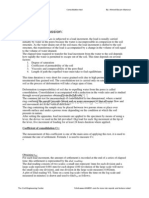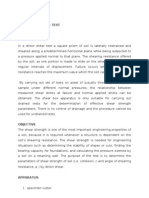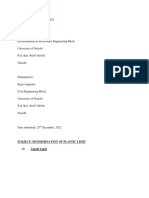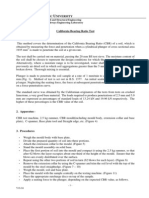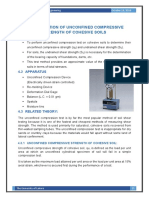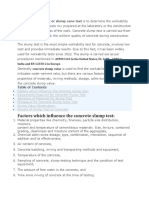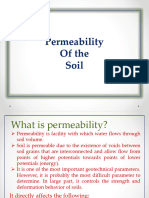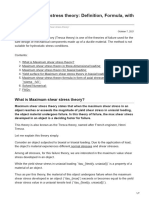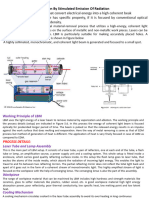Triaxial Test
Triaxial Test
Uploaded by
Tiong V YenCopyright:
Available Formats
Triaxial Test
Triaxial Test
Uploaded by
Tiong V YenCopyright
Available Formats
Share this document
Did you find this document useful?
Is this content inappropriate?
Copyright:
Available Formats
Triaxial Test
Triaxial Test
Uploaded by
Tiong V YenCopyright:
Available Formats
Determination of Moisture Shear Strength of Soils Using Triaxial Apparatus
Experiment 8
Determination of Shear Strength of Soils Using Triaxial Apparatus
General
Soil has very little strength compared to other materials used for building a structure. Moreover,
compared to the maximum soil strength that may be found, there is a very great variation both
from soil to soil and within a given soil type depending on how it was deposited or placed. In
the course of time a series of conventional practices for considering soil strength have been
develop. These practices were based on the type of structure involved, but with little regard to
the kind of soil and almost no concern as to its condition. On the other hand, to an increasing
extent situations are being encountered where lack of knowledge of strength can lead only to
extravagant costs or to failure; therefore more rational approaches are desired.
Objective
The engineering computations concerned with the strength of a soil deal primarily with its
shearing strength; that is the resistance to sliding of one mass of soil against another, and rarely
with the compressive or tensile strength.
Theory
There are many factors which influence the shearing strength that cannot be evaluated with the
direct shear test apparatus. The triaxial shear test apparatus was developed to permit control of
these factors. It should be borne in mind, therefore, that the fact that triaxial testing has been
used does not give assurance that the validity of the result is superior, this test procedure in
which pore-water pressures are measured is used for almost all its shear testing requirements.
Shearing strength is dependent primarily on the normal or confining stress. Under this stress the
soil grains are forced into more intimate contact and the volume of the soil mass is decreased
somewhat. Since the volume of the soil grains cannot be changed appreciably, this volume
change must take place primarily in the voids or pores of the soil .If these pores are completely
filled with water their volume cannot be changed unless some of the water is drained from the
soil mass. If drainage is prevented a stress will be developed in the pore water opposing the
externally applied stress. The developed stress is called pore-water pressure. Even if the pores
are only partially filled with water pore-water pressures will develop, but to a lesser degree.
Since the pore-water pressure is opposed to the normal or confining stress, the shearing
resistance will be reduced whenever positive pore-water pressure is present. On the basis of this
observation for the general case, Coulombs equation must be rewritten:
S = c +( - u) tan
Where u is the pore-water pressure, It is also frequently written:
S = c+ tan
Where tan is the apparent coefficient of internal friction. The true characteristics of a soil are
determined only when pore-water pressures are taken into account during the laboratory test.
Since in any soil the stressed pore fluid will eventually drain from the soil mass, the reduced
Soil and Rock Mechanics Laboratory, Department of Building and Construction, City University of Hong Kong
Determination of Moisture Shear Strength of Soils Using Triaxial Apparatus
strength can be regarded as a somewhat temporary condition. It has been observed that much of
the variation in soil strength can be attributed to pore-water pressure. In consequence
considerable effort is being expended in construction control to minimize the effect of porewater pressure so that initial and ultimate strength in an earth structure will be equal as
practicable.
Apparatus
1. Triaxial Cell with Pedestal.
2. Top-cap with drainage port.
3. Porous disc.
4. Disc perspex for UU test.
5. Rubber membrane.
6. O rings.
7. Membrane placing tool.
8. O ring placing tool.
9. Two part split former, L/D ratio,2:1.
10. Filter Drain (optional).
11. Glass Plate of about 100 mm square and 10 mm thick.
12. Sample trimming device.
13. Caliper.
14. Cutting wire, necessary for fine grain soil only.
15. Sample extruder.
16. Weighting balance.
17. Moisture content determination device, please refer to Exp. 8.
18. Loading frame with speed control.
19. Load ring.
20. Displacement guage.50.0 mm travel.
21. Volume Change measurement device.(for CU and CD test )
22. Bladder Air/water cylinder.
23. Pressure control regulator with pressure gauge.
24. Compressor, (1000 kPa capacity.)
25. Water de-airing device.
26. Air and water connection tubing.
27. Vacuuming device or heating system for saturating the porous disc.
28. Color Chart.
Soil and Rock Mechanics Laboratory, Department of Building and Construction, City University of Hong Kong
Determination of Moisture Shear Strength of Soils Using Triaxial Apparatus
Piston
Post and bracket for axial
deformation measurement gauge
Location for force-measuring
device
Piston bush or seal
Air bleed plug
Cell top
Tie-rods
O-rings
Top cap
Drainage line
Pressurised air free water
Soil specimen
Porous discs
Membrane
Cell body
Base pedestal
Pore pressure valve
O-rings
Cell pressure valve
Flushing system valve
Pore pressure transducer
Back pressure valve
Base drainage valve
fig. 8.1 Typical Triaxial Cell for the Condolidated Drained / Undrained Test
Load frame
Air bleed
Cell pressure
Alternative positions for load
measuring device
Pressure gauges
Triaxial cell
Pressure
maintaining
systems
De-aerating block
Flushing system
Back pressure
Pore pressure transducer
Volume change indicator
Drive from load frame
fig. 8.2 Typical General Arrangement of a Triaxial Test Apparatus for the Condolidated Drained / Undrained Test
Additional apparatus for computerized system with electronic device
29. Data Acquisition System.
30. Computer hardware and software.
31. Transducers of all kinds, which included pressure, displacement, loading and volume
change.
Water de-airing Step
1. Turn on the tap for the supply of water to the water de-airing apparatus.
Soil and Rock Mechanics Laboratory, Department of Building and Construction, City University of Hong Kong
Determination of Moisture Shear Strength of Soils Using Triaxial Apparatus
2. Switch on the water de-airing apparatus, then turn to the water supply position, allowing
water to fill the tank, prevent overflow, then off the tap.
3. Turn to the de-airing position to de-aerated the water for 20 to 30 min. Or until the water is
virtually clear .
4. Turn to water supply position, allowing water to fill to the temperate storing reservoir, then
turn off.
Data logging set-up (For computerized system with electronic device only)
1. Switch on the ADU.
2. Switch on the computer, then enter DS6 and insert a floppy disc. in drive A .
3. Get into DS6 system enter level 2. Select F2 for initialise Transducer. An option is now
presented to enter the channel number.
4. Initialise the group of channels as per Machine used (refer to fig. 3 for Machine layout ).
5. Select Machine no. Then enter the no. as required, Enter F2 for new Sample.
6. Input all the information as per function keys. Finally Save Amendment On Disc (F8).
7. When the reading is in live situation. Enter F2 for Re-set Transducers, then all the
transducers are ready for Zero setting, enter Esc for return to Reading stage.
8. Enter F1=First stage, and select the option stage for running the test.
9. When the testing stage is completed, Save the data to the floppy disc. Then enter to the
second stage or quit the program when all the stages is completed. The above procedure is
just a quick introductions only. For further details please refer to technical manual. All new
operators are request to consult the technical staff before starting the above procedure, as
training is necessary for new comers.
Preparation of test specimen
1. Measure the size of the two-part split former in several locations.
2. Attach the sampling tube to the extruder, normally with the bottom end uppermost , and
jacked out a length of the required sample.
3. Carefully house the sample with the split former, cut off the sample with a wire or knife.
4. Trimmed flat the sample on both ends with the palette knife. Any trimmed off samples
could be for moisture content determination purpose according to Exp. no. 8.
5. Weighted off both the former and the sample for the determination of density, void-ratio,
porosity and degree of saturation value when the S.G. and M/C was known .
Pre-Sample set-up on cell Procedure for UU, CU and CD test
1. Position the cell base on the machine, turn on the valve for the supply of water which is
allocated at the pressure control panel .
2. Checked that both the cell pressure and the back pressure air-bladder cylinder is fully
charged with a supply of freshly de-aired water..
3. Switch on the compressor, allowing the pressure supply is to reach 1000 kpa .
4. Check that all the discharged lines, ports are air free and connections are out of leakage.
5. Open the appropriate valve in order to flush the connections with freshly de-aireated water.
Soil and Rock Mechanics Laboratory, Department of Building and Construction, City University of Hong Kong
Determination of Moisture Shear Strength of Soils Using Triaxial Apparatus
6. Position the volume change pedal at water flow direction, ensured that there is enough
travel for the supply of water for the test to be performed. For further information please
refer to Appendix (A) volume Change Apparatus instructions.
7. Saturated the porous stone with de-airing water in the vacuum chamber.
8. Place two O rings into the O ring placing tool. The membrane should be carefully inspected
for flows or pinholes by stretched it in two directions while holding it against a bright light.
With a membrane stretcher, place the soaked rubber membrane in it. Smash Silicon gel to
the sealing ring , the cell base ,and the top cap .
9. Checked that all the loading ring , displacement gauge ,pressure gauge ,is function properly.
10. For UU test only the cell pressure connection is necessary for the cell and porous stone will
be replaced by rigid corrosion resistance materials or plastic. No back pressure supply and
volume change connection is necessary.
11. Now the Triaxial cell is ready for sample setting.
Materials
Soil, (Completely Weathered Granite.)
Procedure
To determine the undrained shear strength of an undisturbed soil specimen when subjected
to a constant confining pressure and to strain- controlled axial loading with no change in
moisture content.( UU test )
1. Place the cell base with a pedestal of dimensions appropriate to the size of the test
specimen on the compression machine.
2. Place the disc by sliding on the triaxial base pedestal .
3. Place the specimen on to the disc .
4. Place the second disc on top of the specimen then the top cap.
5. Using a membrane stretcher, place the rubber membrane around the soil specimen.
6. Seal the rubber membrane to the base pedestal using two rubber O-rings. ,remove air
pockets from between the membrane and the specimen by light stroking upwards. No
excess air shall be sandwiched between the specimen and membrane
7. Place two O-rings around the top cap..
8. Ensure that the axis of the soil specimen is in vertical alignment.
9. Assemble the cell body with the loading piston well clear of the top cap. Fix the cell
body with the tie rods.
10. By opening the appropriate valve ,fill the triaxial cell with de-aired tap water, ensuring
that all the air is displaced through the bleed plug. Fill the cell as quickly as possible but
without allowing turbulence, which could aerate the water, when it is full, closed the cell
valve.
11. Allowing the piston to raise slowly until it just make contact with the bearing surface on
the top cap, then closed the bleeding plug.
Soil and Rock Mechanics Laboratory, Department of Building and Construction, City University of Hong Kong
Determination of Moisture Shear Strength of Soils Using Triaxial Apparatus
12. With the water supply valve closed, raise the water pressure to the desired value with the
loading piston restrained by the load frame of force-measuring device. Then open the
cell valve in order to administer the pressure into the cell.
13. Adjust the displacement gauge and the loading ring.
14. Select a rate of axial deformation such that failure can be reached within a period of 5
min. to 15 min.
15. Start the shearing by switching on the compression machine.
16. Record sufficient sets of readings of the force-measuring device and the axial
deformation gauge at intervals during compression so that the stress-strain curves can be
clearly define.
17. Check the cell pressure periodically to ensure that it remain constant at within0.5% or 2
kPa whichever is greater. Adjust it if necessary.
18. Terminate the test at a axial strain of at least 5 % more than that after the peak deviator
stress is reached or at an axial strain at least 20%, whichever occurs first.
19. Unload the specimen and dismantle the test assembly, then carried out a moisture
content determination of the sample.
Calculation
(1) From the set of readings ,calculate the axial strain of the test specimen to 0.1% from the
following equation :
H
100
=
H
o
Where
Ho is the initial height of the specimen (in mm)
H is the change in height of the specimen during compression (in mm)
Note: Strains are calculated as cumulative strains ,i.e. the changes in dimension related to
the initial reference dimension.
(2) From the set of reading, calculate the axial force P (to 1 N) applied to the soil specimen
by multiplying the difference between that reading and the initial reading of the forcemeasuring device (in divisions or digits) by its calibration factor (in N/division) .
(3) Assuming that the soil specimen deforms as a right cylinder, calculate its cross-sectional
areas, A (to 0.1mm2), from the following equation:
Ao
A=
100
100
Soil and Rock Mechanics Laboratory, Department of Building and Construction, City University of Hong Kong
Determination of Moisture Shear Strength of Soils Using Triaxial Apparatus
Where
Ao is the initial cross-sectional area of the soil specimen (which equals Do2/4, in
mm2) calculated from the initial diameter Do; and
is the axial strain (in %).
(4) Calculate the measured principal stress difference, i.e. the deviator stress, (1- 3)m, (to
0.1kPa) for sufficient sets of readings to enable the maximum value to be derived, from
the following equation:
P
(1-3)m = 1000
A
(5) Apply a correction to the calculated deviator stresses to allow for the restraining effect of
the membrane, if appropriate. The correction , mb, shall be obtained directly from
Figure.8.3
(6) Subtract the membrane correction, mb, from the measured deviator stresses (1-3)m, to
give the corrected deviator stresses, denoted by (1-3).
(7) Plot a graph of corrected deviator stress against axial strain. Obtain the maximum value
of corrected deviator stress, (1-3)max.
(8) Calculate the value of the undrained shear strength, Su (to o.1 kpa), of the specimen from
the following equation:
Su = 1 ( 1 3 )max
2
(9) Calculate the bulk density , moisture content, w void ratio, e and degree of saturation,
Sr of the specimen as well.
To determine shear strength of a soil specimen, which has been saturated and subjected to an
isotropic consolidation, is then sheared in compression, under a constant confining pressure,
by increasing the axial strain. Drainage is not permitted. CU test
1. Place the saturated porous disc by sliding it on to a layer of water on the triaxial base
pedestal without entrapping air, together with a filter paper disc of Whatman No. 54
filter paper or equivalent saturated in the same manner as the filter paper side drains if
any.
2. Place the soil specimen on the disc centrally without delay and without entrapping air.
3. Place a second saturated porous disc and filter paper disc , with excess water removed,
centrally on top of the specimen . Remove air pockets from between the membrane and
the specimen by light stroking upwards. No excess water shall be sandwiched between
the specimen and membrane.
4. Seal the rubber membrane to the base pedestal using two rubber O-rings.
5. Place two O-rings around the drainage lead connected to the top cap.
Soil and Rock Mechanics Laboratory, Department of Building and Construction, City University of Hong Kong
Determination of Moisture Shear Strength of Soils Using Triaxial Apparatus
6. Open the back pressure valve momentarily to moisten the top cap, and fit the cap onto
the top porous disc without entrapping air. Seal the membrane onto the top cap with the
split-ring stretcher.
7. Ensure that the axis of the soil specimen is in vertical alignment, and that the drainage
line from the top cap does not interfere with the setting up of the cell body.
8. Assemble the cell body with the loading piston well clear of the top cap. Check
alignment by allowing the piston to slide slowly until it just makes contact with the
bearing surface on the top cap, then retract the piston.
9. Fill the traxial cell with de-aired tap water, ensuring that all the air is displaced through
the bleed plug. Fill the cell as quickly as possible but without allowing turbulence, which
could aerate the water.
10. Keep the air bleed plug open until the cell is ready to be pressured, in order to maintain
the pressure at atmospheric.
11. Apply the first cell pressure increment as soon as possible, as required by the saturation
procedure.
Saturation of the specimen shall be achieved by alternative increments of cell pressure and back
pressure
Ensure the back pressure valve and the flushing system valve are closed. Record the
initial pore pressure when steady.
2. Apply an increment of cell pressure of not exceeding 25kPa. ( or 50kPa if the pore
pressure coefficient B, calculate by step 4 below, exceeds 0.9)
3. Observe the pore pressure until it reaches a steady value and record it
u
4. Calculate the value of the pore pressure coefficient B from the equation B =
3
Where
u is the change is pore pressure,
3 is the change is in cell pressure
1.
5.
6.
7.
8.
9.
Keeping the back pressure valve and the flushing system valve closed, increase the
pressure in the back pressure line to a value equal to the cell pressure less the selected
differential pressure neither be less than 5 kPa nor greater than 10 kPa. Record the
reading of the back pressure line volume-change indicator when it reaches a steady
value.
Open the back pressure valve to admit the back pressure into the soil specimen.
Observe the pore pressure and the volume-change indicator readings. When they reach
steady values, record them and close the back pressure valve.
Calculate the volume of water taken in by (or draining out from) the soil specimen from
the difference between the volume-change indicator readings record in step 5 and 7.
Repeat the above step 2 to 7 until the pore pressure coefficient B is greater than or equal
to 0.95 and the back pressure is greater than or equal to 200kPa. Then repeat the above
steps 5 to 7 again, except to leave the back pressure valve open for at least 12 hours in
step 7 and close the back pressure valve afterwards.
Soil and Rock Mechanics Laboratory, Department of Building and Construction, City University of Hong Kong
Determination of Moisture Shear Strength of Soils Using Triaxial Apparatus
10.
Calculate the total volume of water taken up by (or draining out from) the soil specimen
into the air voids by the difference obtained in the above step 7.
Isotropic Consolidation For CU and CD test
Isotropic consolidate the specimen shall be carried out immediately after the saturation stage
using the same apparatus. The effective stress in the soil specimen is increased to the desired
value by raising the cell pressure and dissipating the resulting excess pore pressure to an
appropriate back pressure.
1
2
3
4
5
6
After completion of the saturation stage, keep the back pressure valve closed and record the
pore pressure and volume-change indicator readings.
Increase the cell pressure (3) and back pressure (ub) , if necessary, to give a difference
equal to the desired effective consolidation pressure(3) such that (3 ,) = 3 - ub.
Record the pore pressure until a steady value ui (in kPa ) is reached. Record and plot
readings of pore pressure against time to establish when a steady value is reached. The
excess pore pressure to be dissipated is equal to (ui-ub.)
Record the reading of the volume change indictor. At a convenient moment start the
consolidation stage by opening the back pressure valve.
Record and plot readings of the volume-change indicator and the pore pressure transducer,
at suitable intervals of time.
Allow consolidation to continue until the volume change indicator reading reaches a steady
value and at least 95% of the excess pore pressure has been dissipated, i.e. U 95%.
u u
100 Where U is the degree of consolidation and u is the pore pressure reading at
U = i
ui u b
a given time t.
7 Record the reading of the volume-change indicator and calculate the total change in volume
(Vc ) during the consolidation stage. Record the pore pressure uc (in kPa).
8 The consolidated specimen is then ready for the compression test.
Axial Compression
Carry out compression of the specimen
Set up the triaxial cell on the compression machine if it has been placed elsewhere
during the saturation and consolidation stages
2. Adjust the machine platen, either by hand or by motor drive, until the cell loading piston
is brought to within a short distance of the specimen top cap.
3. Adjust the compression machine to give a rate of displacement dr in mm/minute as to,
f Lc
but not exceeding, that calculated as following relationship d r =
1.
100 Ft 100
Where
Lc
f
is the length of the consolidated specimen;
is the strain at which failure will occur as 0.1%;
Soil and Rock Mechanics Laboratory, Department of Building and Construction, City University of Hong Kong
Determination of Moisture Shear Strength of Soils Using Triaxial Apparatus
4.
5.
6.
7.
8.
9.
10.
10
F
is a coefficient which depends on the drainage conditions, and the type of
compression test, and t100 is the time for 100% consolidation obtained from the squareroot time plot (table 9.1)
Make further adjustment to bring the loading piston just into contact with the seating on
the top cap of the soil specimen.
Close the back pressure valve and ensure the cell pressure valve and pore pressure valve
are open.
Record the date and time to start the compression stage and the initial readings of the
deformation gauge, force measuring device, pore pressure, and cell pressure.
Apply compression to the soil specimen and simultaneously start the timer. Record
sufficient sets of readings of the deformation gauge, force-measuring device and pore
pressure measuring device at intervals during the stress-strain curve can be clearly
defined.
Calculate values of deviator stress (13) (in kPa) and effective principal stress ratio
(1/3) , while the test is still in progress.
Unless otherwise specified, terminate the test at an axial strain of at least 5% more than
that after the peak deviator stress is reached or at an axial strain of at least 20%,
whichever occurs first.
Stop the shearing. Close the pore pressure valve and open the flushing system valve to
protect the transducer.
When multi-stage test is specified, carry out the procedures as follows:
1. Terminate the compression at maximum effective principal stress ratio (1/3) , or the
maximum deviator stress (13) whichever occurs first. Record readings of the
deformation gauge, force measuring device and pore pressure measuring device.
2. Reduce the deviator stress (13) to zero by reversing the motor.
3. Increase the cell pressure (3) but keep the back pressure (ub) at the same value as that at
the consolidation phase of the first stage to give a difference equal to the desired
effective consolidation pressure (3 ) for the next stage. Then repeat consolidation and
compression stage as above.
4. Repeat the steps (1) to (3) above for the third stage of the triaxial test but at the target
effective consolidation pressure for that stage.
Unload the specimen and dismantle the test assembly
1.
2.
3.
4.
5.
Ensure the back pressure valve and the pore pressure valve is closed.
Remove the axial force from the soil specimen.
Reduce the cell pressure to zero and drain the water from the cell.
Dismantle the cell.
Remove the rubber membrane, filter paper side drains (if any) , top cap, porous discs and
the soil specimen from the base pedestal.
6. Sketch the mode of failure of the soil specimen
Measure and process the tested specimen
Soil and Rock Mechanics Laboratory, Department of Building and Construction, City University of Hong Kong
Determination of Moisture Shear Strength of Soils Using Triaxial Apparatus
11
Immediately weigh the whole soil specimen to determine its final wet mass to 0.1g.
Take photographs of the tested specimen both before and after it is split vertically into
two halves, alongside a suitable scale and a colour chart. Describe the soil including its
fabric.
3. Dry the specimen to constant mass at the same temperature as that used for the
determination of moisture content and determine the dry mass to 0.1g.
4. For undisturbed soil specimen, soak it in water until it is sufficiently softened for
breaking up into individual particles. Break it up for inspection. If there are particles of
size larger than one-fifth of the diameter of the soil specimen, determine their percentage
by mass and take photograph of them alongside scale and colour chart.
1.
2.
Calculations
Using the data obtained from the consolidation stage, carry out the following calculations:
1. Calculate the dimensions (volume Vc, in cm3, cross sectional areas, Ac, in mm2 and height,
Hc, in mm) of the soil specimen after consolidation from the following equations.
Vc =Vo- Vc
V
Ac = Ao 1 c
Vo
V
Hc = H o 1 c
Vo
Where
Vo is the original volume of the specimen prior to the saturation stage (in cm3);
Vc is the change in volume during consolidation as determined from the volume of
water draining out of the specimen (in cm3);
Ao is the original cross sectional area of the specimen (in mm2); and
Ho is the original height of the specimen(in mm)
Note 1: Where net volume of water has drained out from the soil specimen during the
saturation stage, V0 shall be taken to be the original volume of the specimen prior
to the saturation stage less that net volume of water.
Note 2: If the change in volume during saturation is significant, it should be estimated and
included with Vc.
2.
Plot a graph of the degree of consolidation(U) against logarithm of time and also plot the
measured volume change (Vc) against square-root time.
Soil and Rock Mechanics Laboratory, Department of Building and Construction, City University of Hong Kong
Determination of Moisture Shear Strength of Soils Using Triaxial Apparatus
12
3. From the plot of degree of consolidation (U) against logarithm of time, read off the t50 (in
minutes ) corresponding to 50% consolidation .
4. Calculate the value of the coefficient of consolidation for isotropic consolidation, Cvi ( to
0.01 m2/year ), from the equation:
cvi =
H + Hc
0.2 H 2
for H = o
t50
2
Where
H is the average height of the specimen during the consolidation stage (in mm); and
t50 is the value determined from the (3) above (in min )
Note: the above formula for the calculation of Cvi assumes drainage is vertical towards one
end of the soil specimen and no side drains are used.
On the plot of volume change against square-root time, draw the straight line which best fits
the early portion of volume change against square-root time (this portion normally lies within
the first 50% of the volume change readings) .Draw a horizontal line through the final point
of the plot .At the point where these lines intersect, read off the value of square-root time,
denoted by t100 and calculate the time intercept of this point, t100 (in min.)
6. Calculate the value of the coefficient of consolidation for isotropic consolidation, Cvi ( to 0.01
m2/year ), from the following equation:
5.
cvi =
D + Dc
1.65D 2
for D = o
t100
2
Where D is the average diameter of the soil specimen during the consolidation stage (in
mm);
Dc is the diameter of the consolidated specimen (in mm) derived from the value Ac
obtained in Step (1) above; and
is a coefficient which depends on the drainage conditions and the length to
diameter ratio (r) of the soil specimen as shown in table 9.1
Note: Where side drains have been used, the value of Cvi derived in this way should not be
applied to engineering settlement calculations because it has been shown to be grossly
in error.
7. Calculate the value of the coefficient of volume compressibility for isotropic consolidation,
mvi (to 0.01 m2/MN ), from the following equation.
Soil and Rock Mechanics Laboratory, Department of Building and Construction, City University of Hong Kong
Determination of Moisture Shear Strength of Soils Using Triaxial Apparatus
13
Vc
Vo
mvi =
1000
ui u c
Where Vc is the change in volume of the specimen due to consolidation (in cm3);
Vo is the original specimen volume (in cm3);
ui
is the pore pressure at the start of the consolidation (in kPa); and
uc
is the pore pressure at the end of the consolidation (in kPa).
8. Calculate the significant testing time tf (to 0.01 minute) for the compression test, from the
following equation:
tf =Ft100
Where F
t100
is a coefficient which depends on the drainage conditions, and the type of
compression test, i.e. undrained or drained (obtained in table 8.1 ); and
is the time for 100% consolidation obtained from the square-root time plot.
Note: the factor F is based on 95% dissipation of excess pore pressure induced by shear,
which is acceptable for most practicable purposed.
9.
Estimate the strain at which failure will occur, f to 0.1%
10. Calculate the rate of axial displacement, dr (in mm/min), to be applied to the soil
specimen from the following equation:
dr =
f Lc
100t f
Where Lc is the length of the consolidated specimen (in mm);
f is the strain at which failure will occur as estimated in step above ( 9 in %);
and
tf is the significant testing time (in min).
Note2: soils if relatively high permeability may give calculated times to failure that are
unrealistically short. The maximum rate of axial displacement in these cases
should be limited to 2% per hour.
After the completion of the test, carry out the following calculations:
Soil and Rock Mechanics Laboratory, Department of Building and Construction, City University of Hong Kong
Determination of Moisture Shear Strength of Soils Using Triaxial Apparatus
14
(i) Calculate the axial strain, 1 (to 0.1%) from the following equation:
H
100
1 =
Hc
Where H is the change in height (from the initial height ) during compression, as
determined from the deformation gauge (in mm); and
Hc is the height of the soil specimen after consolidation (in mm) in equation (1).
Note:
In this procedure, strains are calculated as cumulative strain, i.e. the change in
dimension relative to the initial reference dimension.
(ii) Calculate the cross-sectional area, As (to 0.1 mm2) of the soil specimen normal to its axis,
assuming that it deforms as a right cylinder from the following equation:
As =
100 Ac
100 1
Where
Ac
is the initial area of soil specimen normal to its axis after consolidation (in mm2) .
Note: this equation is based on the assumption that the volumetric strain is zero in an
undrained test on a fully saturated soil specimen
(iii) Calculate the axial force, P (to I N), applied to the soil specimen additional to that due to the
cell pressure from the following equation:
P = Cr R
Where R
is the reading of the force-measuring device (in division )
Cr is the calibration factor of the force-measuring device (in N / div. or digit )
(iv) Calculate the applied axial stress, i.e. the measured principal stress difference, or deviator
stress (1-3)m (to 0.1 kPa) from the following equation:
P
As
( 1 3 )m =
1000
(v) Read out the membrane correction, mb.
(vi) Read out the side drain correction factor from table 9.2 , dr if vertical side drains have been
used
Soil and Rock Mechanics Laboratory, Department of Building and Construction, City University of Hong Kong
Determination of Moisture Shear Strength of Soils Using Triaxial Apparatus
15
(vii) Calculate the corrected deviator stress, (1-3) (to 0.1kPa) from the following equation:
(1-3 ) = (1-3 )m - mb - dr
(viii) Calculate major principal, 1 (to0.1kPa) from the following equation:
1 =(1-3 )+3
Where 3
is the cell pressure
(ix) Calculate the effective major and minor principal stresses, (1 and 3 respectively) (to
0.1kpa )
from the following equations:
1 =1-u
3 =3-u
Where u
is the pore pressure.
(x) Calculate the effective principal ratio = 1/3
(xi) Calculate the coefficient Af A f =
u uo
( 1 3 )
Where uo is the pore pressure in the soil specimen at the start of compression; and
u the pore pressure at failure.
(xii) Calculate the stress parameters, s and t (to 0.1kpa ), in terms of effective stress from the
following equation:
s' =
( '1 + ' 3 )
t =
( 1 3 )
2
(xiii) Calculate the stress path parameters, p and q (to 0.1kPa), in term of effective stress from
the following equations:
P =(1+23)/3
q = (1-3 )
(xiv) Initial moisture content, Wo (to 0.1%),and
Wo =
100(mo md )
;
md
o =
bulk density, o (to 0.01Mg/m3),
1000mo
Ao H o
Soil and Rock Mechanics Laboratory, Department of Building and Construction, City University of Hong Kong
Determination of Moisture Shear Strength of Soils Using Triaxial Apparatus
16
Where mo is the initial wet mass of the specimen ( in g);
md is the final dry mass of the specimen ( in g);
Ao is the initial cross-sectional area of the specimen (in mm2);
Ho is the initial height of the specimen (in mm).
(xv) Moisture content, Wsat (to 0.1%), and bulk density, sat (to 0.01Mg/m3) ,of the specimen
after saturation from the following equations:
Wsat = Wo Where w
100 wVsat
;
md
sat =
1000(mo + wVsat )
Ao H o
is the density of water=1.0Mg/m3;and
Vsat is the total volume of water taken in by the specimen during saturation stage
(in cm3).
(xvi) Moisture content, wcon (to 0.1% , and bulk density, con (to0.01Mg/m3), of the specimen
after consolidation from the following equations:
Wcon = Wsat -
con =
100 wVcon
;
md
1000(mo + wVsat wVcon )
Ao H o 1000Vcon
Where Vcon is the total volume of water expelled during the consolidation stage (in cm3
,negative for volume of water taken in during a swelling stage ).
(xvii) Calculate the final moisture content, wf (to 0.1%), and bulk density, f (to 0.01Mg/m3), of
the specimen from the following equations:
wf =100(mf-md)/md; f =1000mf /AoHo-1000Vcon
Wf =
100(m f md )
md
1000m f
Ao H o 1000Vcon
(xviii) Calculate the dry density ,void ratio, and degree of saturation ,of the specimen at the
initial stage, end of the saturation and consolidation stages and the final stage as well.
Plot the following graphs:
(1) Deviator stress, plotted as ordinate, against the axial strain (usually expressed as percentage
)as abscissa,
Soil and Rock Mechanics Laboratory, Department of Building and Construction, City University of Hong Kong
Determination of Moisture Shear Strength of Soils Using Triaxial Apparatus
17
(2) Effective principal stress ratio 1 / 3 plotted as ordinate, against the axial strain as
abscissa,
(3) Stress path for effective stresses, with values of s as abscissa and t as ordinate, on a plot in
which the vertical and horizontal scales are the same,
(4) Stress path for effective stresses, with values of p as abscissa and q as ordinate, on a plot in
which the vertical and horizontal scales are the same, and
(5) Pore pressure change curve, using the same abscissa as in 1), and pore pressure as ordinate.
Mark clearly the initial pore pressure during the compression stage on the graph.
FAILURE CRITERIA
From the curve of deviator stress against strain the maximum value (at the peak point or
failure condition) is located, and denoted by (1-3)f. The corresponding values of strain (f)
and pore pressure (uf) are also read off. The curve might indicate that the maximum value lies
between two sets of readings, in which case a sensible interpolation should be made. Values of
3, 1, 1 /3 and (denoted by f ) corresponding to the failure condition are calculated as
described above.
Results from a set of three specimens can be presented on one test report sheet by grouping the
graphs together .The stress path plots of
t against s
for the set of specimens are drawn on one sheet. The point on each plot corresponding to the
failure criterion of maximum deviator stress is marked, and the line of best fig is drawn through
the set of points. The angle of slope of the line to the horizontal axis is denoted by , and its
intercept with the t (vertical) axis is denoted buy to.
The shear strength parameters (c () are calculated from the following relationships
Sin = tan
C = to / cos
Shear Strength CD test
Calculations and corrections
The symbols used to illustrate shear strength calculations are the same as for the CU test Axial
strain (%) and axial force ( P newtons ) are calculated as for the CU test. In calculating the
deviator stress (1-3)f. kpa the change in volume of the specimen due to drainage is an
additional factor to be taken into account, The volumetric strain is equal to v =(V/Vc ).100%
and the deviator stress is calculated from the equation.
( 1 3 )m =
P 100
x 1000kPa
x
Ac 100 vs
Soil and Rock Mechanics Laboratory, Department of Building and Construction, City University of Hong Kong
Determination of Moisture Shear Strength of Soils Using Triaxial Apparatus
18
If there is no significant change in pore pressure there is little to be gained from calculating the
principal stress ratio because when plotted it will give a curve identical in shape to the
stress/strain curve.
Table 8.1
Factors for Calculating cv and Time to Failure
Drainage Conditions
Values of
during Consolidation L/D = 2
L/D = r
Values of F (for r = 2)
Drained Test Undrained Test
From one end
r2/4
8.5
0.53
From both ends
r2
8.5
2.1
From radial boundary
and one end
80
3.2(1 + 2r)2
14
1.8
From radial boundary
and two ends
100
4(1 +2r)2
16
2.3
Table 8.2
Corrections for Vertical side Drains
Specimen diameter (mm)
38
Drain correction dr (kpa) 10
50
70
100
150
3.5
2.5
Soil and Rock Mechanics Laboratory, Department of Building and Construction, City University of Hong Kong
You might also like
- EsubieDocument7 pagesEsubieComputer Maintainance Hardware and softwareNo ratings yet
- Material LaboratoryDocument14 pagesMaterial LaboratoryAnonymous tLXKwTNo ratings yet
- Hydrology Lab ReportDocument11 pagesHydrology Lab ReportOchini Chandrasena100% (1)
- Bricklayers Pocket BookDocument22 pagesBricklayers Pocket Bookjhoward2012np0% (1)
- Standard Welded Wire Mesh For Concrete ReinforcementDocument3 pagesStandard Welded Wire Mesh For Concrete Reinforcementmarksantana100% (2)
- Working of Universal Testing Machine (UTMDocument8 pagesWorking of Universal Testing Machine (UTMRajesh Dwivedi86% (7)
- CYCOLOY™ Resin - LG9000 - Europe - Technical - Data - SheetDocument2 pagesCYCOLOY™ Resin - LG9000 - Europe - Technical - Data - SheetmustafaNo ratings yet
- Triaxial TestDocument13 pagesTriaxial TestB S Praveen BspNo ratings yet
- Softening Point of Bitumen: Laboratory - Pavement MaterialsDocument4 pagesSoftening Point of Bitumen: Laboratory - Pavement MaterialsJad Louis33% (3)
- Soil Compaction TestDocument10 pagesSoil Compaction TestChaminduKrishanRupasinghe0% (1)
- Unconfined Compression Tests PDFDocument6 pagesUnconfined Compression Tests PDFHansen A JamesNo ratings yet
- Proctor Standard Comp Action TestDocument9 pagesProctor Standard Comp Action TestlipasemasNo ratings yet
- Determination of Fineness of Cement by Dry SievingDocument2 pagesDetermination of Fineness of Cement by Dry SievingMaterial LabNo ratings yet
- Highway ReportDocument257 pagesHighway ReportMarlon Rampersad100% (1)
- Consolidation TestDocument4 pagesConsolidation TestrbhavishNo ratings yet
- Compaction ReportDocument6 pagesCompaction ReportharinderNo ratings yet
- Mechanics OF Materials Laboratory CEMB121: Experiment No. 6 Title: Forces in Plane Truss (Modular Truss Apparatus)Document8 pagesMechanics OF Materials Laboratory CEMB121: Experiment No. 6 Title: Forces in Plane Truss (Modular Truss Apparatus)Syakirin IsmailNo ratings yet
- HydrometerDocument13 pagesHydrometerShubhrajit MaitraNo ratings yet
- Compaction TestDocument4 pagesCompaction Testmira asyafNo ratings yet
- Liquid and Plastic LimitDocument13 pagesLiquid and Plastic LimitDariusAngelitoNo ratings yet
- Ahe QBDocument20 pagesAhe QBNivedhitha CNo ratings yet
- Stripping ValueDocument3 pagesStripping ValueYasirNo ratings yet
- Lab 3: Atterberg Limits CE 340Document8 pagesLab 3: Atterberg Limits CE 340satyam agarwal100% (1)
- Unconfined Compression TestDocument6 pagesUnconfined Compression TestBahaaAbdalkareemNo ratings yet
- Lab 6: Specific Gravity of Sand and SoilDocument16 pagesLab 6: Specific Gravity of Sand and Soiljads docallosNo ratings yet
- Structural Materials LAB REPORTDocument10 pagesStructural Materials LAB REPORTmusiomi2005No ratings yet
- Soil Investigation Report:: Windy Hill, Central Buyagan, Poblacion, La Trinidad BenguetDocument10 pagesSoil Investigation Report:: Windy Hill, Central Buyagan, Poblacion, La Trinidad BenguetGerry Jimenez Sao-anNo ratings yet
- Lab Sheet - Atterberg LimitsDocument6 pagesLab Sheet - Atterberg LimitsLuqman YusofNo ratings yet
- 5 One Dimensional Flow of Water Through SoilsDocument28 pages5 One Dimensional Flow of Water Through SoilsJenina LogmaoNo ratings yet
- CVE 230. Lab Report 1 (Fresh and Hardened Concrete) .Document4 pagesCVE 230. Lab Report 1 (Fresh and Hardened Concrete) .Juan VillaNo ratings yet
- Plastic Limit ReportDocument7 pagesPlastic Limit ReportAngelo John R. JavinezNo ratings yet
- Lab Direct Shear Test - NewDocument5 pagesLab Direct Shear Test - NewLaBuHiTamNo ratings yet
- Chapter 15Document32 pagesChapter 15Casao JonroeNo ratings yet
- Plastic Limit Lab ReportDocument6 pagesPlastic Limit Lab ReportPeter KamauNo ratings yet
- Determination of Linear ShrinkageDocument2 pagesDetermination of Linear ShrinkageMartinNo ratings yet
- Group 3 (Seksyen4)Document15 pagesGroup 3 (Seksyen4)alnzNo ratings yet
- Liquid Limit Test: Objective: ApparatusDocument4 pagesLiquid Limit Test: Objective: ApparatusAbdulelah SNo ratings yet
- Consolidation LabDocument5 pagesConsolidation LabfostbarrNo ratings yet
- PosterDocument1 pagePosterPiyushKumarNo ratings yet
- CBR LabDocument6 pagesCBR LabKaLeung ChungNo ratings yet
- Determination of Field Density by Core Cutter MethodDocument3 pagesDetermination of Field Density by Core Cutter MethodYogendra Patil100% (1)
- GTE Question BankDocument15 pagesGTE Question BankAbdul G Khader100% (1)
- Centrigugal Extraction Lab TestDocument4 pagesCentrigugal Extraction Lab TestJason OwiaNo ratings yet
- Tar and Bituminous Materials - Methods For Test - Determination of Solubility in TrichloroethyleneDocument10 pagesTar and Bituminous Materials - Methods For Test - Determination of Solubility in TrichloroethyleneDevesh Kumar PandeyNo ratings yet
- Report-Direct Shear Test 1Document20 pagesReport-Direct Shear Test 1Ash BlackForest50% (2)
- LATERAL PRESSURE ProblemsDocument65 pagesLATERAL PRESSURE ProblemsAjay JessaniNo ratings yet
- Addis Ababa Science and Technology University College of Biological and Chemical Engineering Department of Environmental EngineeringDocument17 pagesAddis Ababa Science and Technology University College of Biological and Chemical Engineering Department of Environmental EngineeringNatnael workuNo ratings yet
- Field Compaction ControlDocument2 pagesField Compaction ControlEftikarNo ratings yet
- Experiment No.2 Sieve Analysis of Coarse Grain SoilDocument3 pagesExperiment No.2 Sieve Analysis of Coarse Grain SoilSajid RazaNo ratings yet
- Job#4 Unconfined Compressive StrengthDocument8 pagesJob#4 Unconfined Compressive StrengthMazharYasin100% (1)
- 04 TimberDocument30 pages04 TimberolgaNo ratings yet
- Slump TestDocument4 pagesSlump TestJec SepradoNo ratings yet
- Shrinkage Limit + Liquid Limit by Penetrator MethodDocument8 pagesShrinkage Limit + Liquid Limit by Penetrator MethodrbhavishNo ratings yet
- Exp-6 Permeability by Varying HeadDocument12 pagesExp-6 Permeability by Varying HeadanonymousNo ratings yet
- Soil Compaction LabDocument7 pagesSoil Compaction LabShiva Jake Ramberan100% (1)
- Consolidation TestDocument8 pagesConsolidation TestCasper da MagnificientNo ratings yet
- Exp 4 Unconfined TestDocument6 pagesExp 4 Unconfined TestumarNo ratings yet
- 4 BAA3513 Shear Strength (Part 1)Document31 pages4 BAA3513 Shear Strength (Part 1)Ahmad Rizal AliasNo ratings yet
- Constant Head Permeability TestDocument12 pagesConstant Head Permeability Testanis098No ratings yet
- Oedometer and Direct ShearDocument58 pagesOedometer and Direct ShearGloria AtwebembeireNo ratings yet
- 1.103 Civil Engineering Materials Laboratory (1-2-3)Document5 pages1.103 Civil Engineering Materials Laboratory (1-2-3)prieten20006936No ratings yet
- Determination of Coefficient of Permeability Using Constant-Head Test and Falling Head TestDocument7 pagesDetermination of Coefficient of Permeability Using Constant-Head Test and Falling Head TestVerra Myza AratNo ratings yet
- CVG3109 - Lab - Consolidated Drained Tests For Sand - 2014Document11 pagesCVG3109 - Lab - Consolidated Drained Tests For Sand - 2014Rhedo.AbdNo ratings yet
- CE 323 - Lecture 7Document34 pagesCE 323 - Lecture 7jeanwapelle448No ratings yet
- Summing Up: Professor A. W. SkemptonDocument3 pagesSumming Up: Professor A. W. SkemptonTiong V YenNo ratings yet
- Construction Law and Dispute Resolution MSC CLAWDDocument31 pagesConstruction Law and Dispute Resolution MSC CLAWDTiong V YenNo ratings yet
- Diaphragm WallDocument28 pagesDiaphragm WallTiong V YenNo ratings yet
- 1-ATOMIC STRUCTURE QUESTIONDocument4 pages1-ATOMIC STRUCTURE QUESTIONdalingua21No ratings yet
- Effects of Magnetic Field On Micro FlameDocument125 pagesEffects of Magnetic Field On Micro FlameGOPU3699No ratings yet
- Module 6 MCQDocument68 pagesModule 6 MCQlipibhaiNo ratings yet
- Assignment 1 DriveDocument3 pagesAssignment 1 DriveswamNo ratings yet
- ResGeo202MOOC HW6Document3 pagesResGeo202MOOC HW6Brenda Rojas CardozoNo ratings yet
- Fluid and PVT PropertiesDocument12 pagesFluid and PVT Propertiesedwin_triana_950% (2)
- Physics ActivityDocument15 pagesPhysics ActivitybdjsjdnxnsjNo ratings yet
- Practice Problems On The Navier-Stokes Equations: Answer(s)Document13 pagesPractice Problems On The Navier-Stokes Equations: Answer(s)Pung Kang QinNo ratings yet
- Advanced Chemistry 1Document8 pagesAdvanced Chemistry 1ogbugodwinc0No ratings yet
- (Catalog) JSM-7800FDocument8 pages(Catalog) JSM-7800FSopon PurawattNo ratings yet
- Molecular Sieves - Structure and Structure DeterminationDocument225 pagesMolecular Sieves - Structure and Structure DeterminationHenrique SouzaNo ratings yet
- Mapefill-Hs - Technical Data SheetDocument4 pagesMapefill-Hs - Technical Data SheetSone Aung PyaeNo ratings yet
- Module2 - Transmission LineDocument43 pagesModule2 - Transmission LineAbhinav MauryaNo ratings yet
- RC Design FormulaDocument61 pagesRC Design FormulaKiran AcharyaNo ratings yet
- Die Casting Heat Treatment Process To Increase Strength Part 1Document4 pagesDie Casting Heat Treatment Process To Increase Strength Part 1itslowNo ratings yet
- Buckling Analysis Design of Steel FramesDocument0 pagesBuckling Analysis Design of Steel FramestangkokhongNo ratings yet
- Physical Chemistry Study GuideDocument9 pagesPhysical Chemistry Study Guidekrymxen100% (2)
- Maximum Shear Stress Theory Definition Formula With PDFDocument7 pagesMaximum Shear Stress Theory Definition Formula With PDFkumarisakhi471No ratings yet
- Kumar 1996Document11 pagesKumar 1996Andres PalchucanNo ratings yet
- Orientação ISO 11600Document6 pagesOrientação ISO 11600sahcristine3968No ratings yet
- Assignment #5: Manuel S. Enverga University Foundation College of EngineeringDocument6 pagesAssignment #5: Manuel S. Enverga University Foundation College of EngineeringRozhelle PedernalNo ratings yet
- I Bas 102 2023-24Document14 pagesI Bas 102 2023-24bamiy54090No ratings yet
- Properties of SteamDocument4 pagesProperties of SteamAndrew Grogan100% (1)
- Rohini 69038786578Document4 pagesRohini 69038786578Avinash SinghNo ratings yet
- LBM PPT Vga 2022-23-23-27Document5 pagesLBM PPT Vga 2022-23-23-27Sherazi AshrafiNo ratings yet
- The Tension TestDocument8 pagesThe Tension TestAditya agrawalNo ratings yet
- List Three Examples of Matter Changing From One State To AnotherDocument31 pagesList Three Examples of Matter Changing From One State To AnotherygjyoNo ratings yet














